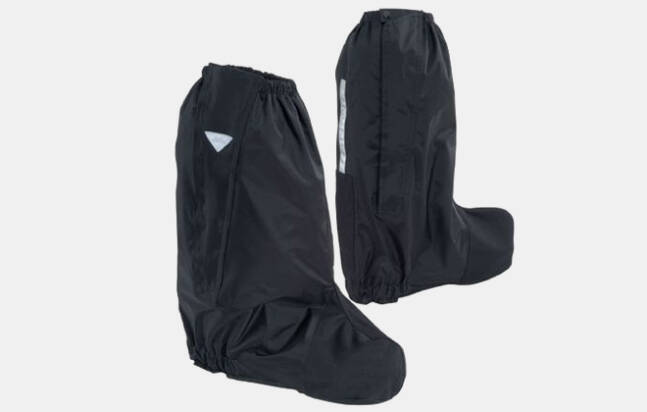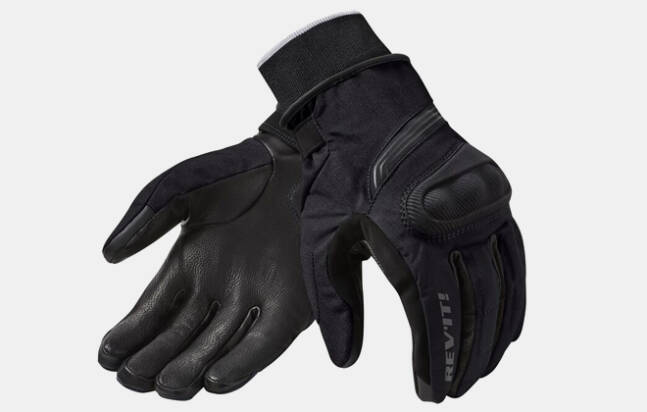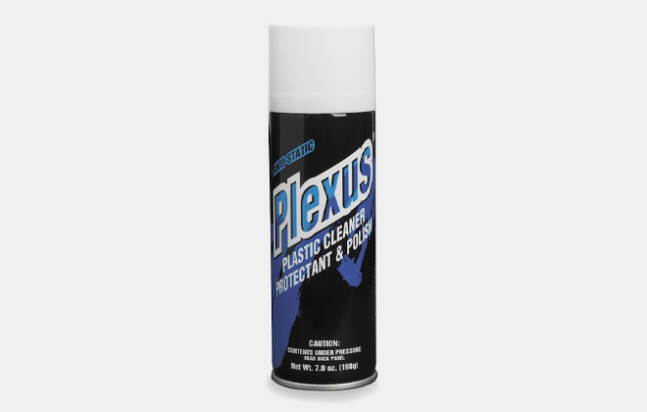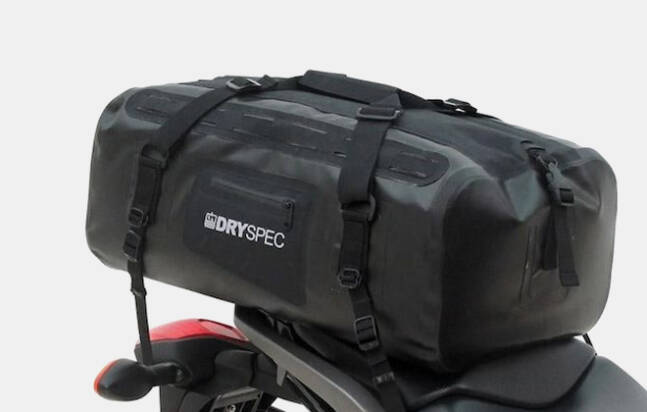Some of the best times I’ve ever had on a motorcycle were spent riding in the rain. That probably sounds crazy, but it’s true. There’s something about the peppering of cool drops of water on sunburnt skin that feels like heaven–as does the relief of finding a gas station canopy to pull under with your buddies on your way to nowhere in particular, and the wet smell of brake dust and gasoline mixing on the highway to excite your nostrils.
The first time I rode across the country, I was about 30 miles into what was supposed to be a 600-mile day from Cody, Wyoming, to Denver. I was still wiping the sleep from my eyes and the grime off my helmet from the 1200-mile day before when I saw a cloud pop up in the distance.
One of the crazy things about that part of the country is that a lot of it is very flat and the weather systems are very large. So, when a storm is coming through, you can sometimes see it from 70 or 80 miles out on the horizon–a stark contrast to the stuff I experience riding in and around my home city of Philadelphia.
The cloud was so dark it looked almost black, way out in the distance. And, slowly but surely, that tiny cloud turned into an entire chunk of sky, filled to the brim and waiting to burst.
I squared off with the storm for hundreds of miles. Sometimes it looked like it was barreling down on me and I was headed straight into it, sometimes it looked like I’d woven around it, and sometimes it looked like I’d beaten it completely by just zigging and zagging my way down the interstate.
After I was sure I’d finally gotten around it, I stopped off in Cheyenne, Wyoming, about 100 miles away from where I needed to end up, and grabbed a quick snack and a bathroom break.
By the time I got back to the parking lot 15 minutes later, the sky looked like it was going to split wide open right on top of me.
Luckily, I was ready for it. I went into my saddlebags, grabbed all my rain gear, and got back on the road. About 15 minutes later, it hit me. I remember cruising by everyone graciously moving out of the way of a motorcycle, probably pitying me as I passed by.
But honestly? Charging that storm, hootin’ and hollerin’ at it, peeling up my visor so I could smell it and feel it on my face in the hot July sun–it was easily one of the most unforgettable moments I’ve ever had in my two-wheeled tenure.
And having the right gear made it all the more bearable.
Rain Riding Safety
Is riding in the rain more dangerous? Technically, yes. Does it require some extra caution and attention? Absolutely. Is it a death sentence? Not even close.
Motorcycles are made for all types of terrain, including rain, sleet, and snow. Your bike can handle a lot of what Mother Nature throws at it. All you have to do is know how to ride in it.
As far as your bike goes, your first safety check is your tires. If you need new tires, don’t ride in the rain. Period. It’s not worth the risk.
Your next safety check is ensuring your carburetor or throttle body aren’t directly exposed to rain, which means having a good air cleaner that won’t let too much rain get sucked into the motor. If you think riding in the rain sucks, wait until you know what it’s like to be stranded on the side of the highway in it.
Your third check is ensuring your lights work. The biggest way to stay safe on your bike is making sure everyone sharing the road with you can see you coming.
Tips for Riding in the Rain
Make sure you keep your bike as low in the RPMs as you can. The lower you are, the less likely you are to spin tire.
Also make sure you’re applying the throttle carefully and smoothly. If accelerating, make sure you’re gently rolling into the throttle. When slowing down, make sure you’re not downshifting into an RPM that’s high enough to break tire traction. But if you can, keep your speed even and controlled.
Make sure you’re giving yourself plenty of room between you and the person in front of you so that you can stop suddenly if you need to. And make sure you’re evading anyone trying to ride your ass. A good offense is a good defense, fellas.
And, of course, stay out of anyone’s blind spot. They can’t see you on a bright, sunny day, and they sure as hell can’t see you when it’s raining with their mirrors covered in precipitation and their windows fogged up.
Finally, try to stay out of the middle lane whenever possible. The middle lane isn’t inherently dangerous, but it’s where you’re most likely to find oil slicks or other road debris that can take you out.
What to Look For in Rain Gear
Your main objective in the search for rain gear is simple: buy stuff that’ll do the best job at keeping you and your stuff dry.
That objective can be reached with all different types of gear at all different price points, but generally you want to look for a few key things:
- Sealed seams
- Waterproof, breathable fabric
- Covered zippers
- Is insulated (depending on season)
- Easy to get on and off
- Easily packable
- Dries quickly
Once you understand the basic assignment, you can start fanning out your search for stuff that looks good and fits your budget.
5 Essential Pieces of Gear for Rain Riding
One-Piece Rain Suit
A classic rain suit is a must. Rain suits come in all shapes and sizes, but I suggest going with a one-piece suit over a two-piece suit. There are plenty of good two-piece rain suits out there, but a one-piece means one less major points of failure between your waist and your belly. You’d be surprised just how much moisture can get up under a jacket if you get caught in an upward and erratic wind stream.
Typically, you want something with a polyurethane-backed nylon shell that’ll give you the best mix of flexibility and durability. Don’t settle for anything without one-piece seams, and try to get something with adjustable cuffs so that you don’t have water shooting up your arms.
This Bilt Tornado Black Rain Suit fits the bill perfectly.
Boot Covers
Having a good pair of sturdy and breathable leather riding boots is a crucial part of your basic riding gear. The problem with breathable leather is that it’s a great way to wind up with soaked feet and socks if you hit a good-sized storm.
The fix here is to get yourself a good pair of quality boot covers. Boot covers are waterproof and usually come in a convenient, seamless design that you can just pull over your boots and slide under your rain suit pant legs.
These Tour Master Deluxe Rain Boots are made from heavy-duty PVC nylon, which means they’ll be able to take a beating while keeping you dry. And at $28, they definitely won’t break the bank.
Rain Gloves
A quality set of gloves is your most important piece of safety equipment aside from your helmet, and you should never kick your stand up with bare hands. That said, finding a set of gloves that fit snug and allow your fingers their full range of motion without limiting your access to your clutch and brake levers is absolutely crucial.
When it comes to rain gloves, you generally have two options: A designated set of gloves you use to ride in the rain, or a set of overgloves that can go over your normal riding gloves.
If you’re on the hunt for a stand-alone set of rain gloves, these REV’IT! Hydra 2 H2O Gloves come with a soft and supple goatskin palm to help you maintain control over your hands, PWR|Shell twill everywhere else, and hydratex waterproofing to ensure sure you stay dry regardless of the weather.
These Dainese Rain Overgloves are incredibly thin and are designed to fit over your everyday riding glove. Not only are they waterproof, but they’re also windproof, which means they’ll keep you dry and warm when you need it most.
Face Shield Polish
This hack is coming straight to you from the “Best Kept Biker Secrets” handbook, only given to full-fledge card-carrying members of the Secret Order of Bad Ass Rider Dudes. Just kidding. But it is a solid tip that not many riders know about.
One of the more annoying safety issues that pop up when riding in the rain is a face shield being matted in water. No matter how much you shake and no matter how fast you go, water builds up on your face shield and obstructs your view. Not only is it annoying, but it’s also really dangerous.
Using a plastic-friendly polish is a great way to keep rain beading off your visor so that your vision is clear enough to see safely see the road ahead. I keep a can of Plexus Plastic Cleaner Protectant Polish in my garage at all times, and I re-apply this stuff frequently. It works.
Dry Bag
Keeping yourself dry on the road is only half the battle. Don’t forget that you also need to keep all your other stuff–clothes, tent, tools, etc.–dry, too. Enter: the dry bag.
Dry bags come in all shapes and sizes for all different types of bikes and applications. You can get yourself a classic sissy bar bag, which fastens directly to your sissy bar and can carry all your gear safely and sturdily.
You can also look into saddlebag setup, over-the-seat setup or even a top-of-tank setup that fastens to the top of your gas tank.
Either way, having something large enough to pack your things in and durable enough to hold up to the road and keep your stuff dry is crucial.
This DrySpect D38 Rigid Drybag is a great universal setup that comes with everything you need to mount it to your bike. It’s made from coated vinyl and coated Cordura and features 100 percent waterproof radio frequency welded seams and a 38-liter total capacity.
Buy Now $195









